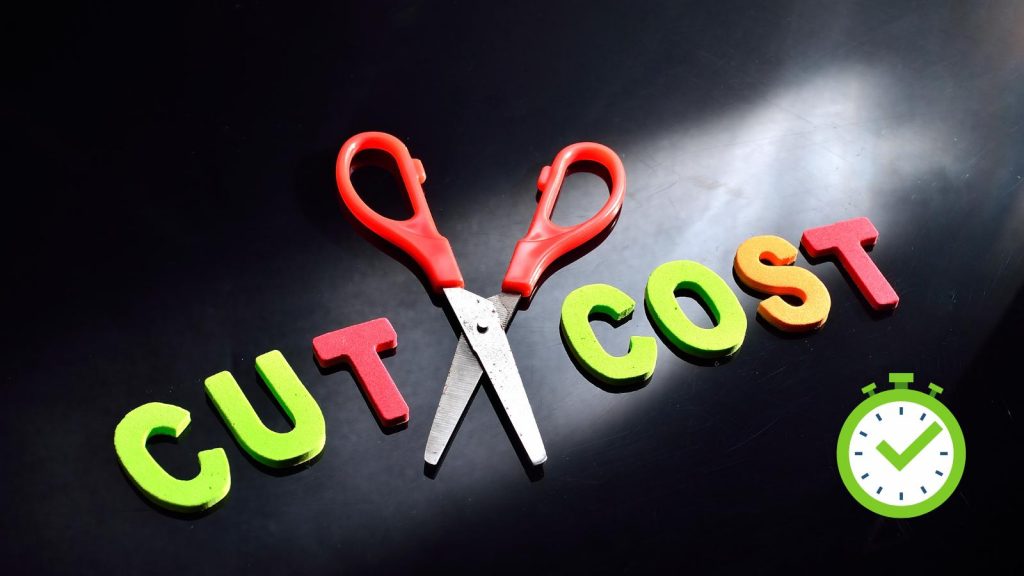It is time for cost cutting to begin at your small business? The phone rings or notifications go off from a client that they can no longer afford your services.
You start losing a few clients and you begin to wonder how you will make more money to pay the increasing bills. After all, inflation has caused your expenses to rise as well.
Table of Contents
What Is Cost Cutting?
The definition of Cost cutting refers to the reduction of expenses in an effort to increase profitability and improve the financial performance of a business.
It involves identifying areas where spending can be reduced. However, it involves making changes to processes, budgets, or operations to achieve this.
The ultimate goal of cost-cutting is to maximize efficiency and minimize waste, while still maintaining the quality of products or services offered.
1. Cost Cutting Initiatives Before It’s Too Late
It is generally good to tighten the budget and cut back on spending when an economy is in a downturn, but the timing of such actions can vary depending on the specific situation and the goals of the individual or organization.
It is important to carefully assess the current economic conditions, take into account potential future developments, and make informed decisions based on that information.
In some cases, it may be necessary to act quickly to reduce expenses and conserve resources, while in other cases, a more gradual approach may be more effective.

2. Where To Start Cost Cutting Measures
First, look over all of your expenses to begin cost cutting. Put them on a priority list, the least at the top and the must-have at the bottom.
- Cleaning Services
- Membership Fees
- Lunches out
- Bonuses
- Tools To Grow Business
- Employees
- Move to a smaller building
- Cut electricity use
Not all of the above may make sense to use in cost cutting. However, you will start with your list to figure out which things can be cut from your budget for your business to survive.
You need to work your cost-cutting list out before implementing changes to your small business.
3. Avoid Unnecessary Expenses
Finally, it’s important to avoid unnecessary expenses when cost-cutting for your small business. Many times we make purchases that seem necessary but are actually just adding extra strain on our budget without providing any real value in return.
Wait a day or two before making any new purchase expenses. See if you really need the product or service first.
Before making any purchases or investments, ask yourself if they’re really necessary or if there’s another solution available that won’t break the bank.
4. Cut Cutting By Bartering Services
Another great way to save money is by bartering services with other businesses. For instance, if you own a restaurant and need fresh produce, you could reach out to a local farmer and offer your services in exchange for fresh produce at no additional cost.
This is an excellent way to get what you need without having to spend any money.
It also helps both parties build relationships that could lead to future transactions down the road.
5. What To Keep In Your Business Budget
There are several things you will want to keep in your budget. Payroll for example unless you are cutting employees.
You will need to keep the electricity and probably the internet to stay in business. There are some things that cost-cutting just won’t work out well. You may want to consider the following expenses for cost cutting:
- Payroll
- Utilities
- Advertising/Marketing
- Software
- Automation
- Customer Service
There are certain areas of your business where cutting corners is not recommended; these include marketing and customer service efforts.
Advertising campaigns should always remain consistent in order to maintain brand awareness and reach new customers; likewise, customer service should never be sacrificed in an effort to reduce expenses.
“Stopping advertising to save money is like stopping your watch to save time.” – Henry Ford
These two areas are essential components of any successful business model so it’s important not to skimp on them in order to stay competitive and profitable in the long run.
6. Don’t Skimp On Technology Today When Cost Cutting
In addition, do not skimp on technology investments such as software programs or hardware upgrades that could potentially improve efficiency or productivity within your organization.
Investing in better tools now may seem expensive but they can provide significant returns over time through improved performance and increased profits from improved operations.
Recently I’ve gone through all the tools I use in my business and I decided to keep most of them.
However, I did switch from one software tool to another in a cost-saving way. I tested it out first to be sure it worked as well as the more expensive version.
7. Keep Your Inventory Low For Cost Cutting Strategies
Keeping your inventory low slashes costs in a few clear ways. First, it cuts storage expenses since you don’t need a ton of space for fewer items.
Less inventory means you’re not tying up your cash in products that just sit around—freeing up funds for more immediate needs. It also trims down insurance costs, as there’s less to protect.
Plus, with fewer items, the risk of damage, obsolescence, or theft drops. You get to order and restock based on actual demand, avoiding overstocking and potential markdowns.
In short, low inventory helps keep your finances lean and efficient as you are cost cutting.
Conclusion: Making Cost Cutting Strategy Decisions
Cost-cutting strategies are necessary for any small business looking to stay competitive in today’s market, but it’s important not to cut corners when it comes to quality or customer satisfaction levels in order to save money.
By automating certain processes, outsourcing when necessary, and investing in quality products and services, small businesses can find ways to cut costs without sacrificing their core values or customer satisfaction levels.
With careful planning and analysis, small businesses can make smart decisions about where they should invest their resources in order to maximize efficiency while still keeping expenses low.
Has your small business started to cut costs in 2024? Do you think your business will need to in the coming year? I’d love to hear about your cost cutting tips and input in the comments below.




